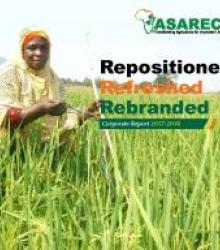| Title | Author | Keywords | Asbract |
|---|---|---|---|
| Annual report 2012 | ASARECA | ||
| ASARECA Annual report 2011 | ASARECA | Pooling regional resources to feed populations: Story titles of highlights of progress made in 2011 include:- Nine drought tolerance genes for maize; Pen-side diagnostic kit for Taenia solium ready for validation; Fifty six (56) striga resistant sorghum lines move towards release; Conserving cassava and sweet potato germplasm for posterity; Vegetables with potential to boost household income and nutrition; Empowering farmers to process fruits for better earnings; Study refutes misconceptions about drylands; Strategies for adapting to climate change; First General Assembly and Getting African information online |
|
| ASARECA Annual Report 2008 | ASARECA | The year 2008 was a successful year in terms of consolidating the positive changes being made in ASARECA towards realizing the vision of making ASARECA a ÔÇ£regional leader in agricultural research and development for improved livelihoods in eastern and central Africa.ÔÇØThe governance structure of ASARECA was changed to expand the Board of Directors and include members representing various stakeholders; work on the Constitution and Governance Manual progressed well; and changes in the management of research for development were also complete. All the seven programme managers were recruited but three of them would report early in the following year. In addition, various new organs became functional. |
|
| ASARECA Annual report 2009 | ASARECA | Theme for Annual report 2009: Generating and scaling out agricultural technologies and innovations for improved livelihoods. 2009 was the year when most of the change processes initiated in 2006 and implemented through to 2008, were completed by ASARECA. |
|
| ASARECA Annual Report 2007 | ASARECA | The ASARECA Annual Report for the Year 2007. The year when the decision was made to transform ASARECA from its original form and function, to a new form and a new function. |
|
| ANNUAL REPORT 2010: Technologies without borders: Sharing regional innovations for food security. | ASARECA | he focus of ASARECA has been to increase the efficiency of agricultural research in eastern and central Africa to facilitate economic growth, food security and export competitiveness through productive and sustainable agriculture. |
|
| ASARECA Annual Report 2014 | ASARECA | To all our esteemed partners and colleagues, let celebrate! ASARECA is 20. Yes, this year2014, ASARECA made 20 years since itwas established in September 1994. The year is also unique in other ways: It marks the first year of ASARECA Second Operational Plan (2014 - 2018) following the successful completion of the 1st Operational Plan (2009-2013). These two plans are based on the 10-year Strategic Plan (2007-2016), which ASARECA is using as a long term direction for research for development interventions in the sub-region. |
|
| Annual Corporate Report 2016 | ASARECA | ASARECA is strategically repositioned to perform a higher level role to enhance sustainable agricultural transformation, economic growth and inclusive development in the Eastern and Central Africa (ECA) sub-region. A repositioned ASARECA is poised to provide leadership as a premier intermediary and interlocutor for research, public, private and civil society organizations to facilitate collaboration in specific AR4D initiatives. This means avoiding duplication, but instead nurture and coordinate effective partnerships to exploit synergies, create a more enabling policy and investment environment, and mobilise resources to invest in AR4D in the ECA sub-region. Niche of the repositioned ASARECA facilitative coordination convening supportive advocacy |
|
| Annual Corporate Report 2015 | ASARECA | 2015 was the second year of implementation of ASARECA Second Operational Plan (OP II). We are delighted to share with you progress made in the promotion of agricultural innovations in Eastern and Central Africa. Two examples from one of our flagship projects facilitating farmers to harness scarce water resources at farm and watershed levels in Kenya and Burundi illustrate this. |
|
| Annual Corporate Report 2017-2018 | ASARECA | Strengthening, catalyzing and coordinating the Eastern and Central Africa sub-regional agricultural research for development initiatives by strengthening and integrating capacities; supporting and coordinating development and scaling up of technologies and innovations; advocating for an enabling policy environment, functional markets and institutions; and managing and communicating knowledge and information to accelerate sustainable agricultural transformation and growth for shared prosperity and improved food and nutrition security and livelihood of the ECA people. |
Search
Technical Reports
Copyright © 2025. All rights reserved.
Designed By ASARECA


